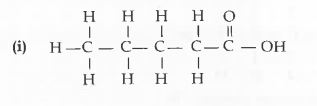ಎಂಟು ಧಾತುಗಳ ಪರಮಾಣುಗಳಾದ A, B, C, D, E, F, G & H ಇವು ಒಂದೇ ಸಂಖ್ಯೆಯ ಇಲೆಕ್ಟ್ರಾನಿಕ್ ಕವಚಗಳನ್ನೂ ಬೇರೆ ಜೇರೆ ಸಂಖ್ಯೆಯ ಹೊರಕವಚಗಳನ್ನು ಹೊಂದಿವೆ. A & G ಧಾತುಗಳು ಸೇರಿ ಅಯಾನಿಕ್ ಸಂಯುಕ್ತವನ್ನು ಉಂಟು ಮಾಡಿವೆ, ಹಾಗೆಯೇ ಆ ಸಂಯುಕ್ತವನ್ನು ಸಮುದ್ರದ ನೀರಿನಿಂದಲೂ ಪಡೆಯಬಹುದು, A & B ಧಾತುಗಳ ಆಕ್ಸೈಡ್ಗಳು ಪ್ರತ್ಯಾಮ್ಲೀಯ ಗುಣವನ್ನು, ಹಾಗೆಯೇ E & F ಧಾತುಗಳ ಆಕ್ಸೈಡ್ಗಳು ಆಮ್ಲೀಯ ಗುಣವನ್ನು, D ಧಾತುವಿನ ಆಕ್ಸೈಡ್ ಹೆಚ್ಚು ಕಡಿಮೆ ತಟಸ್ಥವಾಗಿದೆ. ಮೇಲಿನ ಮಾಹಿತಿಯನ್ನಾಧರಿಸಿ ಕೆಳಗಿನ ಪ್ರಶ್ನೆಗಳಿಗೆ ಉತ್ತರಿಸಿ. ಇವುಗಳಲ್ಲಿ ಯಾವ ಒಂದು ಧಾತುವು ಅರೆಲೋಹ ಅಥವಾ ಲೋಹಾಭವಾಗಿದೆ?
Step by step video & image solution for ಎಂಟು ಧಾತುಗಳ ಪರಮಾಣುಗಳಾದ A, B, C, D, E, F, G & H ಇವು ಒಂದೇ ಸಂಖ್ಯೆಯ ಇಲೆಕ್ಟ್ರಾನಿಕ್ ಕವಚಗಳನ್ನೂ ಬೇರೆ ಜೇರೆ ಸಂಖ್ಯೆಯ ಹೊರಕವಚಗಳನ್ನು ಹೊಂದಿವೆ. A & G ಧಾತುಗಳು ಸೇರಿ ಅಯಾನಿಕ್ ಸಂಯುಕ್ತವನ್ನು ಉಂಟು ಮಾಡಿವೆ, ಹಾಗೆಯೇ ಆ ಸಂಯುಕ್ತವನ್ನು ಸಮುದ್ರದ ನೀರಿನಿಂದಲೂ ಪಡೆಯಬಹುದು, A & B ಧಾತುಗಳ ಆಕ್ಸೈಡ್ಗಳು ಪ್ರತ್ಯಾಮ್ಲೀಯ ಗುಣವನ್ನು, ಹಾಗೆಯೇ E & F ಧಾತುಗಳ ಆಕ್ಸೈಡ್ಗಳು ಆಮ್ಲೀಯ ಗುಣವನ್ನು, D ಧಾತುವಿನ ಆಕ್ಸೈಡ್ ಹೆಚ್ಚು ಕಡಿಮೆ ತಟಸ್ಥವಾಗಿದೆ. ಮೇಲಿನ ಮಾಹಿತಿಯನ್ನಾಧರಿಸಿ ಕೆಳಗಿನ ಪ್ರಶ್ನೆಗಳಿಗೆ ಉತ್ತರಿಸಿ. ಇವುಗಳಲ್ಲಿ ಯಾವ ಒಂದು ಧಾತುವು ಅರೆಲೋಹ ಅಥವಾ ಲೋಹಾಭವಾಗಿದೆ? by Chemistry experts to help you in doubts & scoring excellent marks in Class 10 exams.
Updated on:21/07/2023Topper's Solved these Questions
- ಆಮ್ಲ, ಪ್ರತ್ಯಾಮ್ಲಗಳು ಮತ್ತು ಲವಣಗಳು - ಲವಣ, ಅವುಗಳ ಲಕ್ಷಣಗಳು ಮತ್ತು ಉಪಯೋಗಗಳುBOOK - OSWAAL PUBLICATIONCHAPTER - ಆಮ್ಲ, ಪ್ರತ್ಯಾಮ್ಲಗಳು ಮತ್ತು ಲವಣಗಳು - ಲವಣ, ಅವುಗಳ ಲಕ್ಷಣಗಳು ಮತ್ತು ಉಪಯೋಗಗಳುEXERCISE - EXERCISE
122 Videos
- ಕಾರ್ಬನ್ ಮತ್ತು ಅದರ ಗುಣಲಕ್ಷಣಗಳು, ಅನುರೂಪ ಶ್ರೇಣಿ ಮತ್ತು IUPAC ಹೆಸರುಗಳುBOOK - OSWAAL PUBLICATIONCHAPTER - ಕಾರ್ಬನ್ ಮತ್ತು ಅದರ ಗುಣಲಕ್ಷಣಗಳು, ಅನುರೂಪ ಶ್ರೇಣಿ ಮತ್ತು IUPAC ಹೆಸರುಗಳುEXERCISE - EXAMPLE
6 Videos
Similar Questions
P , Q ,R ಮತ್ತು S ದ್ರಾವಣಗಳ pH ಮೌಲ್ಯ ಕ್ರಮವಾಗಿ 7.8, 1.0,13.0 ಮತ್ತು 1.4 ಇವುಗಳಲ್ಲಿ ಹೆಚ್ಚಿನ H+ ಅಯಾನುಗಳ ಸಾರತೆ ಹೊಂದಿರುವ ದ್ರಾವಣವನ್ನು ತಿಳಿಸಿ ?
View Solutionಈ ಕೆಳಗಿನ ಸಂಯುಕ್ತಗಳ ಹೆಸರನ್ನು ಬರೆಯಿರಿ.

View SolutionIn Fig. 4.103, CD and GH are respectively the medians of ABC and EFG . If ABC~FEG , prove that (FIGURE) ADC~FHG (ii) CDGH=ABFE (iii) CDB~GHE
View Solutiona. b. c. d. e. f. g. h.
View Solutionयदि, U={a,b,c,d,e,f,g,h}, तो निम्नलिखित समुच्चयों के पूरक ज्ञात कीजिए।
A={d,e,f,g}
View SolutionIf U = {a, b, c, d, e, f, g, h}, A = {b, d, f, h} and B = {a, d, e, h}, find the following sets.
B'
View SolutionIf U = {a, b, c, d, e, f, g, h}, A = {b, d, f, h} and B = {a, d, e, h}, find the following sets.
(B')'
View SolutionIf U = {a,b,c,d,e,f,g,h} , find the complement of the following sets:
A= {a,b,c} , B ={d,e,f,g} , C ={a,c,eg}, D = {f,g,h,a}.
View SolutionIn Figure, CD and GH are respectively the medians of ABC and EFG . If ABC~FEG , prove that (i)ADC~FHG (ii)CDGH=ABFE (iii)CDB~GHE
View SolutionIn Figure, DEFG is a square and ∠BAC=90 . Prove that (i) A G F ~ D B G(ii)AGF~EFC (iii) D B G ~ E F C(iv)DE2=BDxEC
View SolutionABCD is a square E, F, G and H are points on AB, BC, CD and DA respectively, such that AE=BF=CG=DH. Prove that EFGH is square.
View SolutionIf U = {a,b,c,d,e,f,g,h}, find the complements of the following sets:B = {d,e,f,g}
View SolutionGiven that the universal set U = {a, b, c, d, e, f, g, h} and A = {a, b, c, d, e}, B = {a, c, e, g), C= {b, c, f, g} then determine
(A−B)−C
View SolutionGiven that the universal set U = {a, b, c, d, e, f, g, h} and A = {a, b, c, d, e}, B = {a, c, e, g), C= {b, c, f, g} then determine
A−(B−C)
View SolutionLet A = { b,d,e,f }, B = { c,d,g,h} and C = {e,f,g,h} .Find :
A- B
View SolutionLet A = { b,d,e,f }, B = { c,d,g,h} and C = {e,f,g,h} .Find :
B-C
View Solution
